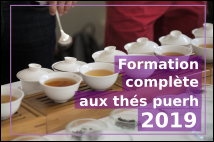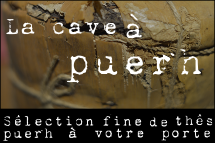After the general article on tong puerh (Pu Er tea) puerh and origin Beeng Tse Chi Cha Here is a short documentary article on how these flip flops are made of tea, the traditional way and using herbs and bamboo leaves. This is a relatively long work even for someone experienced practitioner day long usually takes more than 5 minutes.
Although some large industries as DaYi not use bamboo tong and now prefer to craft bag size cakes, most flip flops are still produced in this way and tied by hand, from the small family producer village of Wu Yi, the big factory Menghai or Fengqing.
As I mentioned in the previous article manufacturing methods differ slightly from one manufacturer to another. It is generally used three pieces of bamboo, but some may use more, which will be pre-cut or cut during packaging tong (as in the photos below). Similarly, the tong can be strung from herbs or thin ropes, but as often or uses the son of iron, less aesthetic but more convenient to make. Finally, each producer to his technique in how to assemble bamboo leaves, build herbs, etc., which makes each tong.
These pictures were made in summer 2010 at the factory in Menghai Cheng Sheng Hao.
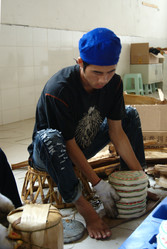
|
The battery of seven cakes is first placed in the middle of a first sheet of bamboo. |
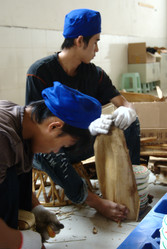
|
Grabbing the sheet by the two ends, the battery is carried on a thin flat stone (left in the previous photo).
The sheet is then slid and folded vertically (it will be both the bottom of the tong and some of its side).
|
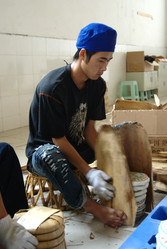
|
A second sheet is placed next to the first on the side of the tong and be a part of the circular edge of the tong.
|
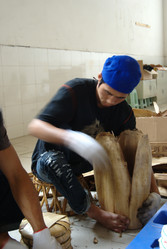
|
That while the first two sheets are held by the feet, a third sheet is added to the periphery of the side finishing tong.
|
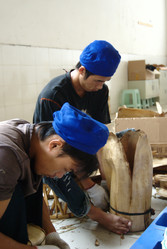
|
The three sheets are temporarily held in their position by a wide elastic.
|
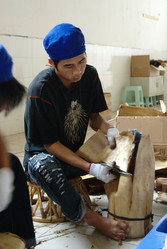
|
Two sheets are cut to size.
|
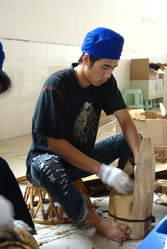
|
The first sheet is folded on the patties.
|
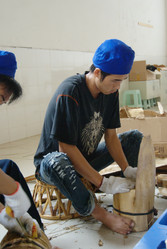
|
A second leaf alights on the first train to the top of the tong.
|
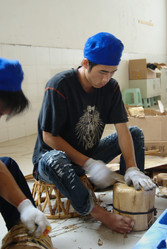
|
The third sheet is longer than the previous two is then folded. It crosses the top of the tong and down on the opposite side.
|
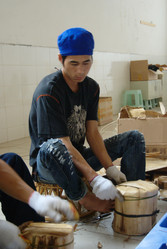
|
Fresh grass (green) is then used is just embrace the thong and packaged in the first disc.
|
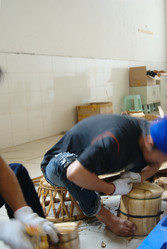
|
The thong is so tied once and strongly tight.
|
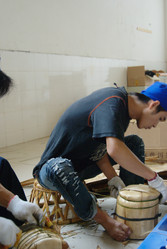
|
The operation is repeated a second time at the second disc.
|
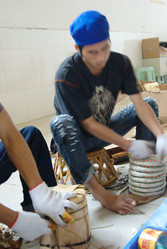
|
The thong is then passed to a second worker (left) who placed third grass (in the third cake) while that the first worker resume the steps we have just seen with a new stack of pancakes.
|
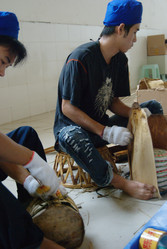
|
At every turn herbs are carefully tied around the cake and with each other.
|
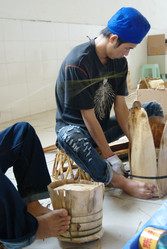
|
Once half of the stringed tong is returned and then maintained using the feet.
|
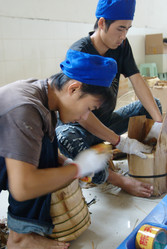
|
The final laps of herbs are thus made to maintain the last sheet cakes and acting background.
|
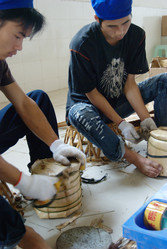
|
The excess is then cut sheet at the bottom.
|
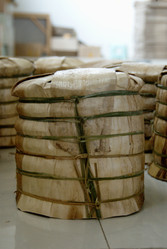
|
And here is the finished product, beautifully crafted thong. It will then according to the producers remain unchanged, or be stamped on the top pyrographed before being packed jian or cardboard and leave the workshop.
|
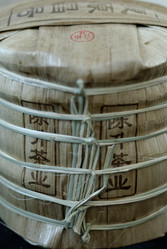
|
This is the case for example of the great poker-tong, aesthetics particularly well, produced by the same producer for the vintage 2012's Tea Yi Wu
We note in passing the desire to give a noble dimension to the tea, probably in reference to the ancient mythical producers Yi Wu, but also the evolution between the thong out of the factory Chen Sheng Hao in 2010 (previous photos of the article), and this one came out two years later in 2012.
|
 This page is not a real translation but just an automatic translation generated by computer of the original article, written in French language! Its not good... but better than nothing!
This page is not a real translation but just an automatic translation generated by computer of the original article, written in French language! Its not good... but better than nothing!

